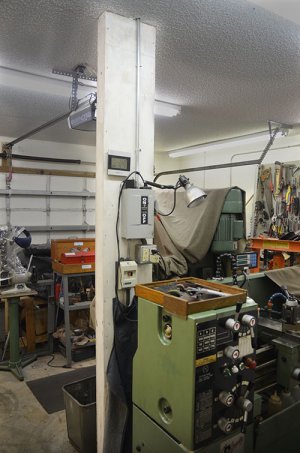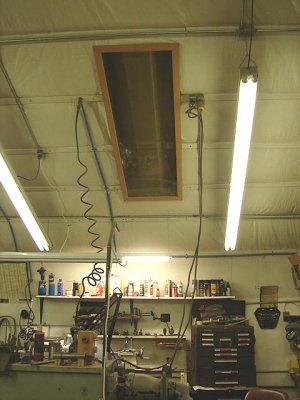-
Welcome back Guest! Did you know you can mentor other members here at H-M? If not, please check out our Relaunch of Hobby Machinist Mentoring Program!
You are using an out of date browser. It may not display this or other websites correctly.
You should upgrade or use an alternative browser.
You should upgrade or use an alternative browser.
Routing Power To Lathe In Center Of Room
- Thread starter boostin53
- Start date
- Joined
- Jul 20, 2014
- Messages
- 182
I did the overhead thing, but took a slightly different route. My space is 20 x 30 feet, so I have a lot more empty center floor space. And the lathe could get moved at any time if a new machine showed up. So my shop arrangement is far from being firmly defined.
I already had a 7 ft power cord on the lathe. Then I made a 220V 4-prong extension cord about 20 ft long and strung that up overhead. The thinking was I might get a mill or welder requiring 220V in the future, and I definitely can't use them at the same time. Better for me to have one really good extension cord I can move around, rather than have to keep adding expensive breakers and outlets.
But the others have it right. The trick with overhead wiring is figuring out how to keep the weight of the vertical cable from cutting into the insulation of the delivery cable where it transitions from vertical to horizontal. That 15 pound dead weight will surely get you in trouble over time.
I already had a 7 ft power cord on the lathe. Then I made a 220V 4-prong extension cord about 20 ft long and strung that up overhead. The thinking was I might get a mill or welder requiring 220V in the future, and I definitely can't use them at the same time. Better for me to have one really good extension cord I can move around, rather than have to keep adding expensive breakers and outlets.
But the others have it right. The trick with overhead wiring is figuring out how to keep the weight of the vertical cable from cutting into the insulation of the delivery cable where it transitions from vertical to horizontal. That 15 pound dead weight will surely get you in trouble over time.
- Joined
- Nov 9, 2011
- Messages
- 253
I built a frame of 2x4's and plywood to support the switchbox and convenience outlets, and the cable that runs from the switchbox to the lathe and on the other side, another one for the mill. My electrician ran conduit from the breaker box on a nearby wall across the ceiling and down to the outlets.
I wanted the switchboxes to isolate the machines from the grid when not in use, we have a lot of lightning storms here. Found out after I got them that local code required a magnetic restart device on each machine, so those are mounted there too.

I wanted the switchboxes to isolate the machines from the grid when not in use, we have a lot of lightning storms here. Found out after I got them that local code required a magnetic restart device on each machine, so those are mounted there too.

- Joined
- Oct 24, 2014
- Messages
- 208
correct, and in a normal garage/home environment, a twist lock and cord would be all that's necessary.Ceiling drops are how it's done in industry.
- Joined
- Oct 24, 2014
- Messages
- 208
correct, and in a normal garage/home environment, a twist lock and cord would be all that's necessary.Ceiling drops are how it's done in industry.
- Joined
- Nov 27, 2015
- Messages
- 603
Yeah, but power rails and PDUs would sure be nice!correct, and in a normal garage/home environment, a twist lock and cord would be all that's necessary.
 Steve Shannon, P.E.
Steve Shannon, P.E. 
- Joined
- Mar 31, 2015
- Messages
- 184
Yeah, but power rails and PDUs would sure be nice!️
Steve Shannon, P.E.

What was that about your PE?
Mine are hung with stainless cable from the ceiling to duplex boxes and outlets.
So far, it's better than the previous owner of the house who was an electrician
- Joined
- Mar 31, 2015
- Messages
- 184
Steve Shannon-how do I put a smilie next to my previous statement 
- Joined
- Nov 27, 2015
- Messages
- 603
Looks like you figured it outSteve Shannon-how do I put a smilie next to my previous statement

Sent from my iPhone using Tapatalk


